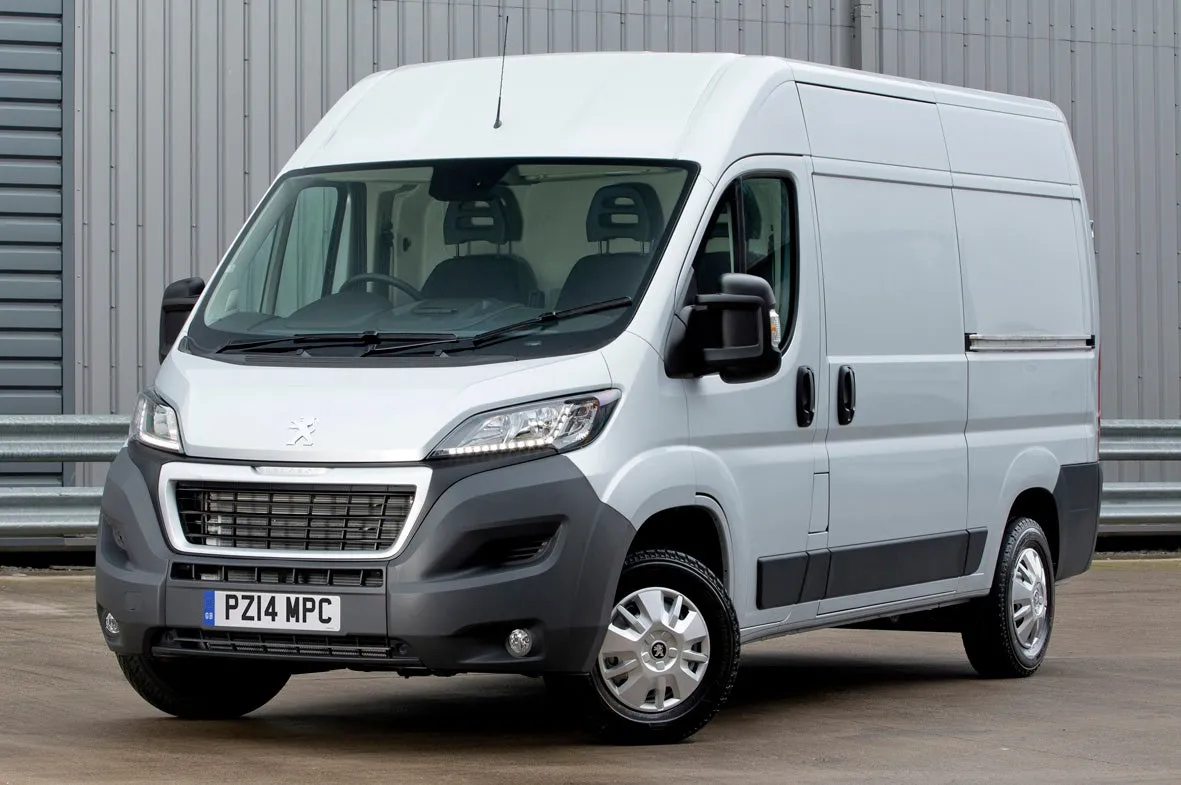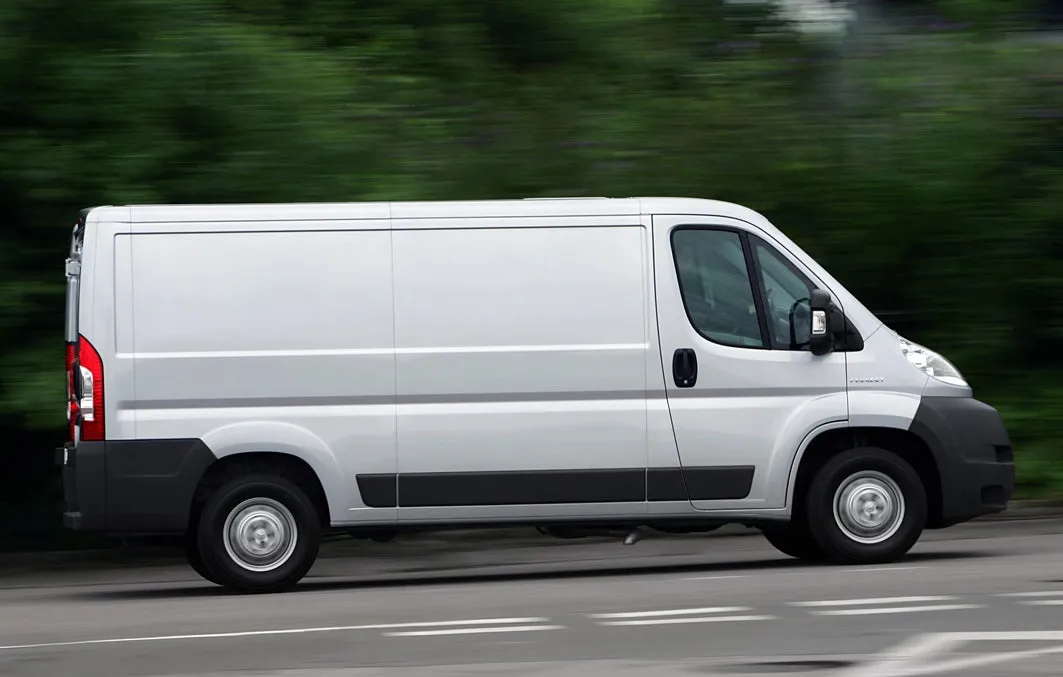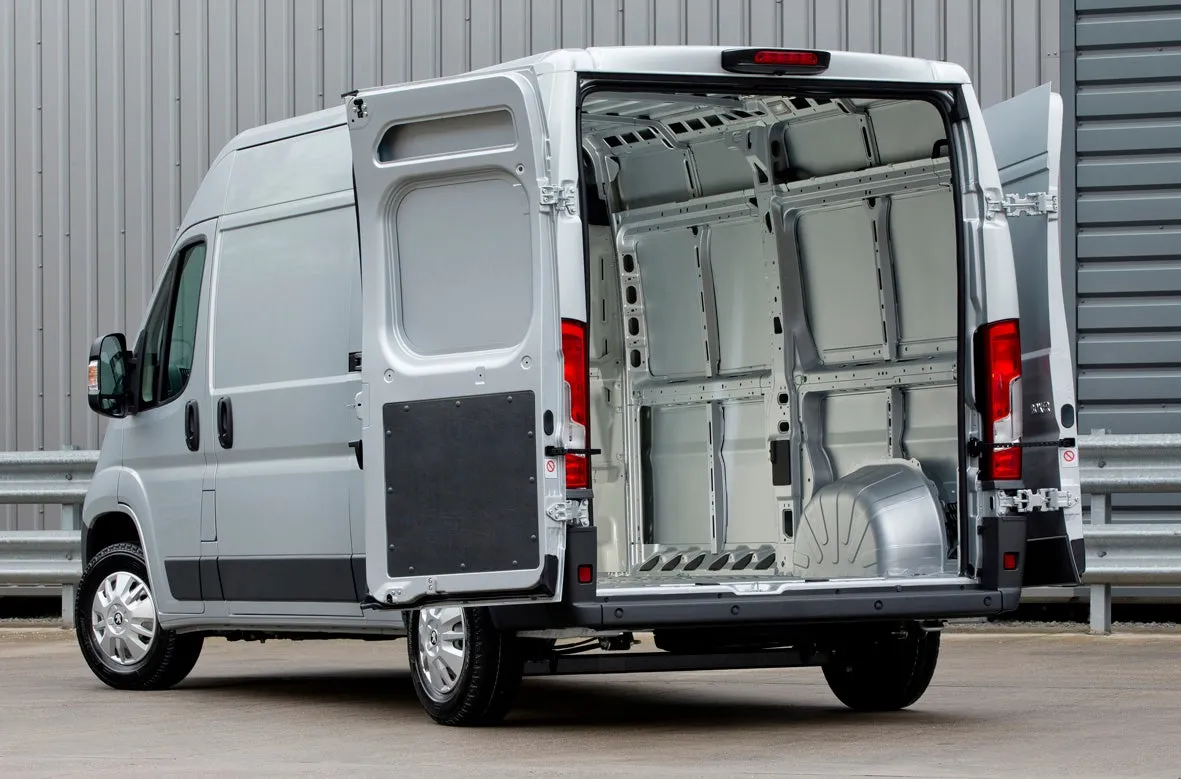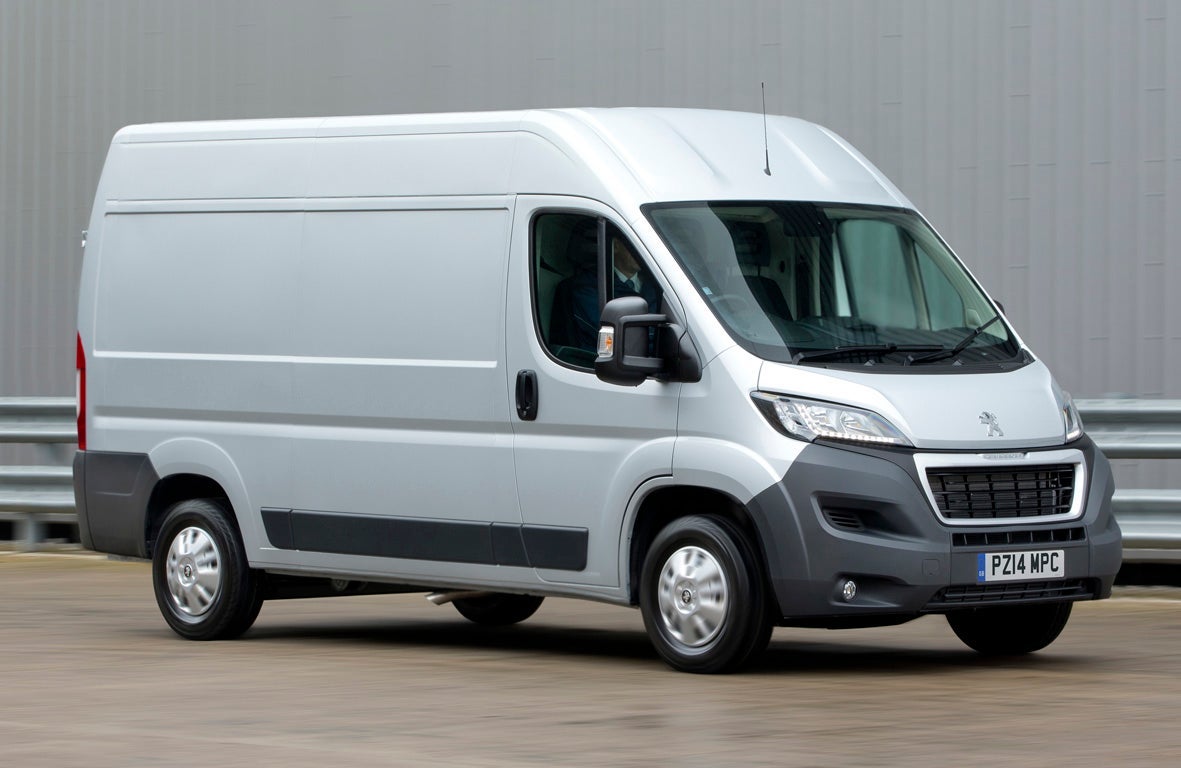Peugeot Boxer Review 2024
Written by Andrew Brady
Quick overview
Pros
- Strong diesel engines
- Excellent warranty
- Huge range of shapes and sizes available
Cons
- Noisy engines
- Outdated cabin
- Passenger bench seat not comfortable on longer trips
Overall verdict
"The Peugeot Boxer is a bit of an old workhorse in many senses. It has been around in its current form since 2006, although it has had several updates in that time to freshen things up."

However, the fundamentals remain largely the same. Given that those include an impressively wide range of body styles, some strong payloads and some powerful engines, it is not hard to see why it has remained popular with buyers and Peugeot has persevered with it for so long.
The Boxer was originally co-developed with Citroen and Fiat, meaning that there are plenty of parts that are shared with the Relay and the Ducato respectively. The Boxer has had plenty of different engines over its lengthy life, but as of the 2019 update it is offered with just the two diesel engines – a pair of 2.2-litre units with 120PS or 140PS.
There have been plenty of tweaks to the engine ranges in its lengthy history, though. In 2016 Peugeot brought in a Euro6 compliant 2.0-litre HDi, which replaced Euro 5 2.2-litre and 3.0-litre HDi diesels. The Boxer has even been around long enough that the early versions featured Euro 4 diesels.
In 2022, Peugeot added an all-electric version, called the e-Boxer, to the range. Rather than an in-house EV conversion, Peugeot sends the diesel model to a third-party company who strip out the engine and gearbox and squeeze in an electric motor and battery pack. There's a 37kWh short range version, or a 70kWh long-range model, and both are available in three panel van sizes, as a window van or a chassis cab.
The Boxer’s age means that it lags behind other large vans when it comes to the overall refinement and driving experience. The lack of insulation and the relatively gruff engines mean there is a fair amount of noise while you are on the move and the cabin feels less geared towards comfort than more modern rivals. It does the basics well, though, as the suspension is well controlled and the Boxer handles with a reassurance that will have kept customers coming back time and again.
One of the big selling points for the Boxer is its versatility and the wide range of different versions that are and have been available. There are dropside and tipper conversions, chassis cabs, Luton vans, crew vans and minibuses all available. These come through Peugeot’s ‘Built for Business’ program, so you get the manufacturer’s backup and can deal with them directly rather than having to head off to a third-party converter.
The standard panel van comes with plenty of practicality, with four heights and three lengths available. This means there is up to 17 cubic metres of space on offer, while the payloads go up to a hefty 1570kg. The payload in the electric e-Boxer is limited to a maximum of 1150kg.
To help you make the most of this practicality there are touches such as rear doors that have multiple opening positions. They swing out to 90 degrees as standard, but a retractable link system lets you move them out to 180 degrees, while you can also have doors that open out to 270 degrees to lie flat with the side of the van as an option.
The floor is ribbed as standard and you can get either eight or 10 lashing hooks to ensure everything is tied down securely, while there are black Teflon plastic lined panels in the rear which act to protect the load.
It’s not the most modern or the most luxurious, but many will want their large van to be a tool above everything else and the Boxer shines in many of the areas that count.
Looking for a used van for sale? We've got 100s of Peugeot Approved Used Cars for Sale for you to choose from, including a wide range of Peugeot Boxer vans for sale.
Is the Peugeot Boxer right for you?
The reasons for buying a Boxer are very much the ones that will appeal to the head rather than the heart. It is a big van that will carry a lot of stuff and it will be relatively efficient while you drive around with all that stuff in the back.
Rivals are more comfortable, more modern and much more refined, but the Boxer is like a tool – it’s basic but very good at doing what it was originally designed to do when it first launched all those years ago. That’s why it is still largely unchanged after such a long time and what it remains popular. The same goes with the electric e-Boxer: it's not very sophisticated, but it does the job.
What other vans are similar to the Peugeot Boxer?
There are almost two distinct classes in the large van category, with the Boxer closest in style and function to the likes of the Fiat Ducato and Citroen Relay with which it shares many of its parts. The equally ageing Renault Master and its siblings – the Nissan NV400 and Vauxhall Movano – are also worth considering as basic workhorses.
The more modern Ford Transit, Mercedes-Benz Sprinter and the Volkswagen Crafter all offer a greater degree of refinement and technology.
Comfort and design
"The driver of the Peugeot Boxer gets plenty of space and getting comfortable is made all the easier by a wide range of adjustment on the seat on all models."

You can move the seat up and down as well as in the usual directions, while the steering wheel adjusts for reach as well. The seat is well padded and supportive as standard, but you have to step up from the basic trim to get lumbar support and an arm rest.
There are some oddities in the layout, though, with the handbrake positioned between the driver’s seat and the door. This has a real benefit in that it minimises the chance of bashing into your passenger’s leg when parking up, although it will take a mental shift to stop you inadvertently reaching towards the conventional handbrake’s position. It also means that you have to make sure you don’t catch yourself on it when you get in and out, but again this is something you adapt to relatively easily.
The gear lever is set up high up on the dash and close to the steering wheel, which means it’s easily reached without risking bashing into your middle-seat passenger.
The rest of the dash is basic in its layout, with the big chunky buttons and controls for the temperature all clear and easy to see and read. The big air vents don’t have any fancy styling, but are again easily adjusted.
The dashboard in the electric e-Boxer is a bit unusual, and it's clear it isn't an in-house conversion. It uses the same dials as the regular Boxer, but half the needles have been removed, while the range display is in a screen in the rear-view mirror. The temperature knob for the ventilation system isn't connected, either - instead there's a cheap-looking screen next to the steering wheel.
Quality and finish
The build quality in the Boxer feels generally solid, but the finish is the definition of unspectacular. There is little in the way of luxury with the materials hard and robust without much in the way of luxury at any turn.
The Boxer is a bit of a rarity in that there isn’t really even much in the way of extra stylistic or comfort-geared touches as you head up the range. You can get a leather covered steering wheel and gear lever, but only as a cost option and it isn’t included even on the top-level Asphalt trim.
All versions get the same dark grey cloth upholstery with no option of upgrading to anything that is more robust or luxurious. You can upgrade to alloy wheels, though, with a choice of 15- or 16-inch rims.
There are some nods to improved comfort as you head up the range, with air conditioning and lumbar support added on the more road-going models, the Professional and Asphalt versions. There is also a driver’s armrest on these versions. Heated seats are available, too, but again only as an option.
Infotainment
The basic Boxer gets little in the way of fancy infotainment systems, but it does get some important basics. Every model gets DAB digital radio, a USB socket and Bluetooth. It also gets steering-wheel mounted controls.
If you go up to the more-utilitarian Grip model then you get the same functionality but with a five-inch colour touchscreen. The Professional model adds satellite navigation to the mix as well while the top-level Asphalt gets another USB charging socket on the dashboard.
It’s worth noting that none of the Boxers come with Apple Carplay or Android Auto, so the Peugeot sat nav is your only option if you need guidance.
The nav is a TomTom system and this is clear and relatively slick, but the small five-inch screen means it is not as easy to see as the bigger systems in rival vans, especially the large modern layouts in the likes of the Mercedes Sprinter and Volkswagen Crafter.
All Boxers also get the ability to connect to Peugeot’s fleet management services – Free2Move Connect Fleet. The actual packages cost extra, normally a monthly fee per vehicle, but you don’t have to add in any extra hardware.
Space and practicality
The Peugeot Boxer comes with the ability to carry three adults across the front of the cabin, as you would hope and expect from a large van – it’s certainly the bare minimum from the rivals.
The positioning of the main touchpoints in the front of the cabin mean that there is a good amount of room for all of these adults, too. There is a better than normal amount of legroom and shoulder room in particular, largely because the gear lever is positioned high up and near the steering wheel and because the hand brake is tucked down between the driver and the door and not in between the driver and the middle passenger.
The seat on the far side from the driver is a standard one, while the one in the middle also has a flip down back that can be used as a writing desk. As a result it is a little firmer, and both are quite upright.
There is pretty much every size and shape of Boxer available, with four lengths and three heights on offer in the panel van alone. This means that you can have internal loading space ranging from eight cubic metres up to a whopping 17 cubic metres. The load length is an impressive 2670mm in the shortest model while the longest is just over four metres. This sounds great, but there are longer options out there – the Crafter can take just shy of five metres for example.
Payloads are also impressive, although just shy of the class best. The lowest available is 1,125kg while the L2H1 model with the more powerful engine is capable of taking 1,570kg. This doesn’t quite match the Vauxhall Movano’s best-in-class figure, but it is only about 50kg shy of it so it isn’t far off. If you need to make the most of this, then Peugeot also offers a heavy-duty suspension option, which can be added to any model in the range and is standard on the Grip model.
Although the payload of the electric e-Boxer is limited to 1,150kg in the biggest version, that figure is competitive with other electric vans. It's also available in a variety of sizes, while the batteries under the floor don't effect cargo space in the slightest.
There is also a wide range of conversions available in the Boxer, with a tipper, dropside and various forms of Luton van all offered. The crew van comes with a three-seat bench in the rear, taking the carrying capacity up to six, but only the two outer seats get three-point belts – the middle one has to make do with a lap belt.
Handling and ride quality
"The Boxer is a traditional van in how it handles, in that it is more comfortable and settled when it is fully laden. When it is carrying a lighter load it can feel a little less planted on the road and a little nervous as a result. Load it up and it feels more settled and confident."

The suspension is relatively firm, which means that it is capable of tackling corners without throwing you or your cargo around too much. There are two optional suspension systems, one is a twin-leaf reinforced system that is designed for those who want to carry heavier loads on a regular basis. This one in particular is a little bouncy when you are driving around with nothing in the back. The other setup is geared more towards comfort and is a self-adjusting rear pneumatic system.
The power assisted steering system does a good job at making a big van more agile at lower speeds. The turning circle ranges from just over 11m for the shortest model and just over 14m for the longest versions, and you can spin the wheel from lock to lock in just under 3.9 turns. It provides good feel despite the assistance, which helps you feel a little more confident, too.
It is an older steering system, though, and there are no clever technological systems here to help out, like crosswind assist or lane keep assist, so driving in gusty conditions will be a little more testing than in modern vans, like the Ford Transit, which come with such systems as standard.
The electric e-Boxer actually handles a little better than the standard Boxer when unladen, because the battery's weight low to the ground makes it more stable. It's a heavier van, however, although the ride is okay.
Engines and gearboxes
There has been a wide range of engines offered in the Boxer over the years, with the Euro6d-TEMP versions consisting of a pair of 2.2-litre diesels. These were introduced at the 2019 update and offer 120PS or 140PS.
Despite their relative newness, they don’t feel as modern as the engines in rivals such as the Volkswagen Crafter, thanks largely to the noise and vibration you get in the cabin. This is as much due to the insulation as anything, though.
The Boxer has always offered engines that are up to the task of hauling around the big van and all its bulk, though, so these should be no different. The previous 2.0-litre diesels and the 2.2-litre versions that went before that were all capable of getting the Boxer up to speed and then keeping pace with motorway traffic.
The latest versions come with a six-speed manual gearbox as standard, which helps boost refinement on the motorway slightly, as it allows it to settle at lower revs when at cruising speeds. Some older entry-level models only had a five-speed manual gearbox, which was cruder and less relaxed at higher speeds.
The smaller engine will suit most people as it has plenty of pulling power, but you are limited to which versions you can pair it with – it is only offered on the shortest and lowest model. If you want anything longer than the L1H1 then you are left with no choice and have to go for the 140PS diesel.
There is also no choice when it comes to gearbox as there is just a manual gearbox offered – no automatic here.
The electric Peugeot e-Boxer uses a 120PS electric motor powering the front wheels. Progress is pretty leisurely, particularly off the line where there's none of the peppy performance of your typical electric car. Once above 30mph it's fine, however, while it tops out at 75mph.
Refinement and noise levels
The Boxer is a noisy van on the move, which will start to wear if you spend any length of time behind the wheel. This is the case regardless of which engine you go for, and has been the case throughout the past engines, too. The older the engines are, the noisier they were – the 2.0-litres made big strides on from the 2.2-litre options that preceded them.
The biggest issue is the lack of insulation, which allows loads of road and engine noise into the cab. This is the case even if you are going at lower speeds, so it feels like a raucous experience, especially when pitted against the far quieter and more refined Volkswagen Crafter and Ford Transit, which do a much better job at leaving you relaxed after a long drive.
There is the option of removing the bulkhead, but doing this would make the cabin a very noisy place indeed, not to mention one that could be more dangerous without protection between the passengers and the cargo.
Of course, the electric e-Boxer is smooth and quiet at any speed when it comes to the motor. But the lack of a diesel drone means you hear other noises, such as wind and road noise and even the power steering pump working away.
Safety equipment
The Boxer’s old-fashioned design means that it lacks lots of the clever tech that you get on more modern vans. The basic model comes with electronic stability control and ABS while the driver gets an airbag but that is about it.
You don’t get much more as you step up through the range, with the mid-range Professional only adding an alarm and the more rugged Grip model getting hill descent control.
The top model is the version that gets a bit more in the way of handy kit, including rear parking sensors, auto lights and wipers and the drive assistance pack. This brings speed limit recognition and recommendation, a distance alert system and lane departure warning system. Because the steering system is an older powered system, there is no ability for the van to intervene if you drift out of the lane and guide you back in. This also means there is no crosswind assist, as there is in many of the rival big vans. If there is a big gust of wind that catches the side of the van, you’re on your own.
The final handy addition on the top model is the rear parking camera. There are a few more bits on the options list – you can get a passenger airbag, curtain airbags, cruise control and a tyre pressure monitor. All versions get a full-size spare wheel as standard.
Like many vans, the Boxer hasn’t been assessed by EuroNCAP.
MPG and fuel costs
"As the engines were updated through the Boxer’s life they became more efficient. The latest versions, the 120PS and 140PS 2.2-litre diesels – offer much the same economy as one another. They both officially average up to around 35mpg, with only around half a mile per gallon between them so there is little reason to choose one over the other on economy grounds."

Official figures for the previous versions might look a lot higher – they were in the high 40s for the 2.0-litre diesels – but these were assessed under the previous and more lenient NEDC testing procedure. Real world results would have been comparable to or worse than the modern 2.2-litre equivalents.
The electric e-Boxer costs substantially more to buy than the regular diesel Boxers. You'll need to make sure that's offset by your reduced fuel costs, although as many cities are banning or charging older diesel models you may not have a choice in the matter.
Insurance groups and costs
The insurance groups for the Boxer are all relatively low, with the big van’s basic nature working in its favour when it comes to keeping costs down. The groups range from 5 up to 8 for the standard panel van, which makes it one of the cheapest models in its class to cover.
VED car tax
Taxing a van is different to taxing a car and it matters not how much it emits or how much it costs. Every van is subject to the same flat-rate of VED and they all qualify for the same Benefit-in-Kind company car tax rate.
The electric e-Boxer doesn't cost anything in road tax, which is a handy bonus.
How much should you be paying for a used Peugeot Boxer?
"The Boxer holds its value in a comparable way to other large vans, which is to say it isn’t great at it. After three years and 60,000 miles it will be worth around a third of its original price, which is good news for buyers looking for a second-hand bargain."

Vans with more fancy equipment tend to perform better on the used market, but this is not the Boxer’s main selling point so the top models will hold onto their value at similar rate to the rest of the range.
Rivals perform slightly better in many cases because of this, with the Crafter and new Mercedes Sprinter likely to be more desirable when they reach their third birthday thanks to the high levels of technology on offer.
You won't find an electric e-Boxer on the used market any time soon, as it's only just been launched. Prices start from just over £51,000 new, and that's excluding VAT.
Trim levels and standard equipment
Stick to the base models of the Boxer if value really is your main focus – the kit levels higher up the range are not sufficiently desirable to warrant stepping up if you just want the big Peugeot as a tool. There are a couple of things that you could add, but there isn’t really anything that is a must add – air conditioning and cruise control possibly.
The engine choice is dictated by your space requirements. If you need anything other than the L1H1 model then you will have to have the more powerful engine. If you can get away with the smallest size then you only get the lower-powered version.
Get our latest advice, news and offers
Keep me updated by email with the latest advice, news and offers from heycar.
By submitting you agree to our privacy policy



